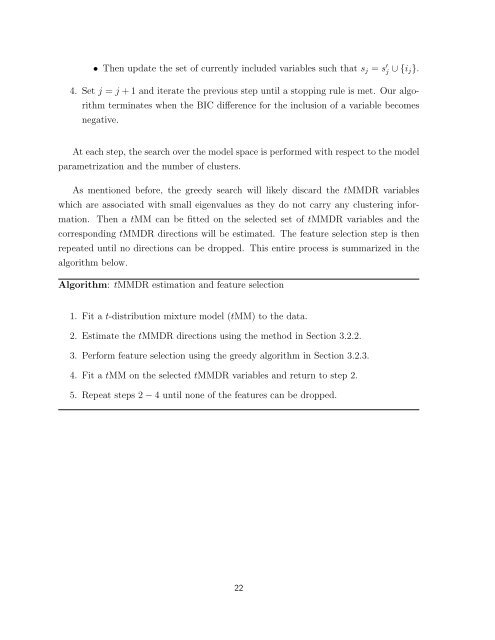Dimension Reduction for Model-based Clustering via Mixtures of ...
Dimension Reduction for Model-based Clustering via Mixtures of ...
Dimension Reduction for Model-based Clustering via Mixtures of ...
Create successful ePaper yourself
Turn your PDF publications into a flip-book with our unique Google optimized e-Paper software.
• Then update the set <strong>of</strong> currently included variables such that s j = s ′ j ∪ {i j }.4. Set j = j + 1 and iterate the previous step until a stopping rule is met. Our algorithmterminates when the BIC difference <strong>for</strong> the inclusion <strong>of</strong> a variable becomesnegative.At each step, the search over the model space is per<strong>for</strong>med with respect to the modelparametrization and the number <strong>of</strong> clusters.As mentioned be<strong>for</strong>e, the greedy search will likely discard the tMMDR variableswhich are associated with small eigenvalues as they do not carry any clustering in<strong>for</strong>mation.Then a tMM can be fitted on the selected set <strong>of</strong> tMMDR variables and thecorresponding tMMDR directions will be estimated. The feature selection step is thenrepeated until no directions can be dropped. This entire process is summarized in thealgorithm below.Algorithm: tMMDR estimation and feature selection1. Fit a t-distribution mixture model (tMM) to the data.2. Estimate the tMMDR directions using the method in Section 3.2.2.3. Per<strong>for</strong>m feature selection using the greedy algorithm in Section 3.2.3.4. Fit a tMM on the selected tMMDR variables and return to step 2.5. Repeat steps 2 − 4 until none <strong>of</strong> the features can be dropped.22
















